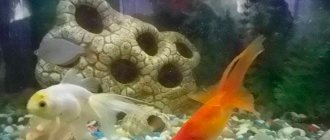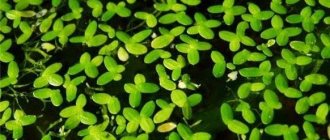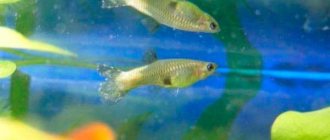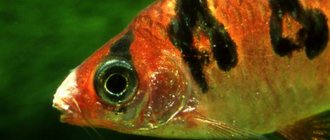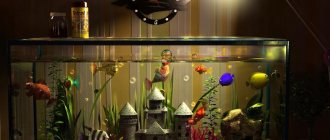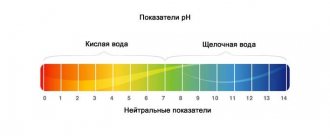- Disease Prevention
- Fin rot
- Ichthyophthiriasis (semolina)
- Treatment of fish with saline solution
- Exophthalmia (bulging eyes)
- Dropsy
- Oodiniosis: stuck together fins
- Columnaria
- Video - fish diseases (bettas)
Have you noticed in the pet store plastic containers with brightly colored fish with huge fins, gracefully swimming among algae and castles? This is the most beautiful species of fish called Betta splendens, also known as betta fish. Aquarists adore these fish, because they are easy to care for, but they are prone to various diseases.
Proper care, attentiveness, and compliance with a number of rules will help you avoid illnesses of your beloved pets and prolong life expectancy. Knowing what diseases a betta fish can develop and their signs, you can be calm about the health of your pet, which will delight you with its beauty and incredible grace for many years.
In this article, experts will tell you what diseases of betta fish exist and how to treat them. So, let's go.
Disease Prevention
These lovely fish suffer from bacterial and parasitic diseases. It’s easy to understand that your pet is sick: the fish hides at the bottom, refuses to eat, becomes covered with plaque and white spots, the color changes, and the fins are affected.
Let's figure out what causes diseases in betta fish:
- Poor water quality (fraught with decreased immunity and death of fish);
- Expired, low-quality food (immediately remove uneaten food);
- Garbage. Depending on the capacity of the aquarium, you need to regularly clean the aquarium once a week and change about 1/3 of the water;
- Insufficient filtration;
- An excess of pets in one container;
- Plants from other bodies of water;
- Impossibility of spawning (females get cancer, males become lethargic);
- Avitaminosis.
Important! Monitor the expiration dates of the food and do not overfeed the fish (you can find out the exact amount of food from the staff). An excess of food, as well as a lack of it, negatively affects the underwater beauties with sweeping fins.
Have you noticed the same symptoms in several fish? Check and change the water, install additional aeration, carry out the disinfection procedure. It’s worse if only one of the fish is sick: this indicates the onset of a bacterial disease, fraught with negative consequences. Let's figure out what diseases of aquarium betta fish occur and find out the main symptoms.
Main reasons
If the water in the aquarium is foaming, the first thing to talk about is insufficient cleaning. The foam film on the surface is nothing more than an accumulation of organic matter. It appears in new and used aquariums and often harms waterfowl. Organic compounds are proteins and amino acids that are necessarily present where living things exist. The filtration system does not remove contaminants, but creates foam from them. Next, let's talk about the factors that cause excessive foaming.
Water quality
Before starting the aquarium, it is customary to fill it with water and leave it for several days. This is necessary so that the chlorine evaporates, beneficial bacteria appear and biobalance is established. Transparent but slightly yellowish water is called “veined”. If it is too soft, it is more likely to form foam than if it is hard. In the absence of a putrid odor, bloom, or mucus, foamy water can be used without fear. Otherwise you will have to replace it completely.
Overpopulation
When there are a lot of fish in an aquarium, this is fraught with various troubles:
- there is not enough free space for swimming;
- strong pets take food from weak ones;
- aggressive individuals attack peace-loving ones, tearing off their fins;
- waste quickly accumulates (food that has fallen to the bottom, excrement, scales);
- the water becomes cloudy and foamy;
- the fish are in constant stress, change color, and stop reproducing.
Overpopulation harms not only the fish, but also the owner: tank maintenance (cleaning, aeration, filtration) becomes more difficult.
On a note! The general rule for calculating the number of waterfowl is: per 1 cm of fish length - 1 liter of water. Thus, one small fish should have approximately 3 liters of liquid, and a large one – 10 liters.
Quantity and quality of feed
One of the most obvious causes of foam is uneaten food. Most of the fish feed in the upper layer of water. If food particles fall on the ground, they will remain there, begin to decompose, and bubbles will appear from them. Acidified food greatly pollutes the water body, especially if there are no bottom-dwelling fish - catfish, loaches. To avoid such consequences, feed your fish in portions. It is better to leave them slightly hungry than to allow the over-provided food to spoil.
Irregular care
Rare water changes and insufficient cleaning of the tank walls are two more reasons for foaming. Nurse fish and a filter system are not all ways to purify water. Your home pond requires additional care. If you do not pay proper attention to your aquarium, over time a lot of debris will form in it. You can understand why the water in the aquarium began to foam at first glance: the inside is dirty, food remains, scales, and pieces of fins are visible. Probably somewhere in the scenery there is a fish corpse lying and rapidly decomposing.
Proper care will help deal with foam and prevent its further occurrence. It is necessary to regularly siphon the soil, wash the decorations, and catch large waste. In addition, it is required to partially change the water weekly: no more than 30% of the volume at a time.
Frequent water changes
Beginner aquarists make a serious mistake - they often change the water. Because of this, there is no constant biobalance in the aquarium. The water does not have time to become colonized with beneficial bacteria, and pathogenic microorganisms multiply at a rapid pace. As a result, a foamy film forms on the surface, mucus on the walls of the vessel, and cloudy “clouds” in the water column. The solution is quite simple: install an aerator and filter and interfere less often with the natural environment. Portioned fluid changes will help preserve the biological system.
Scenery
The water also becomes cloudy because new accessories are dipped into it. Most often, untreated driftwood causes foaming. Natural materials that contain signs of life (bacteria, fungi) pollute water and emit harmful substances. Caves, grottoes and other decorations can be painted and varnished. Low-quality chemicals are extremely dangerous for pets. If the water foams after decorative elements have been added to the aquarium, they should be removed. The vessel must be filtered, the aerator started, and in difficult cases, the contents of the aquarium must be completely replaced.
Attention! Fish like to hide in decorations; sometimes they die there and lie unnoticed for a long time. This is how decorative items cause foam and odor to appear in the aquarium.
Enhanced aeration
The most harmless and even beneficial foam for fish are the bubbles emanating from the aerator. The water is enriched with oxygen, and the fish do not feel its lack. However, with increased operation of the aerator, the organic matter in the water is whipped up. You may notice that a foam “cap” has formed above the surface of the aquarium. Under normal conditions, there should be no foam in clean, standing water.
Filter problems
When an insufficiently powerful filter is installed in an aquarium, it does not cope with water purification. The filter element becomes dirty quite quickly and stops retaining waste. As a result, blue-green algae and cyanobacteria are activated. The activity of microorganisms leads to the appearance of small bubbles in the aquarium. Over time, if the filter is not cleaned, the bubbles form dense foam. This problem can be easily resolved: you need to select a suitable filtration device and rinse it in a timely manner.
Chemical substances
Sometimes you can observe that the water becomes cloudy or foams after adding bulk additives or solutions. Trying to make the grass thicker and stronger, aquarists add special plant fertilizers to the soil. The chemical components in their composition, reacting with organic residues, provoke the appearance of foam. The same effect occurs when using medicines for fish. If foam has already accumulated in the aquarium, it needs to be caught and removed, and the filter must be turned on at full power. In the future, preliminary testing of the chemical in a separate tank will help predict the situation.
Cockerels
Fans of spectacular betta fish know another reason for the appearance of foam inside the aquarium. It is associated with a special method of spawning. When a cockerel is preparing to reproduce, it takes in air from the surface with its mouth, digests the bubbles and releases them into the water. After some time, a “nest” of bubbles accumulates on the water surface of the aquarium. The cockerel squeezes out the eggs, placing each egg in a separate “bag”. Thanks to a special enzyme, the foam is quite strong and can reliably hold future fry.
This is interesting! If a cockerel lives in an aquarium alone, without a representative of the opposite sex, it still produces foam: it breathes, secreting saliva along with bubbles.
Fin rot
The cause is the bacterium Pseudomonas, which got into the water along with food or new inhabitants. Usually it clings to young or weakened individuals, but if detected untimely, it can destroy the entire population of the aquarium.
The symptoms are:
- Lethargy.
- Sudden change in color.
- Ulcers or bluish plaque on the body.
- Cloudiness of the cornea.
- Blowing bubbles;
- Ugly, drooping, stuck together fins.
Have you noticed one or more signs of fin rot? Begin immediate treatment, and until complete recovery, quarantine the sick fish, otherwise it will infect other pets.
Most often, specialists treat betta fish with streptocide or another antibacterial agent. Thus, treating betta fish with metronidazole gives a quick effect and improved health.
In addition, you can use special products sold in pet stores.
In addition, treatment can be carried out with the following drugs:
- Bicillin-5 (penicillin substance with bactericidal action).
- Biomycin (general purpose antimicrobial antibiotic).
- Malachite green. Treatment is carried out for a maximum of five days (gradually increasing the dosage from 0.5 to 0.7 ml). Only freshly prepared solution is used, the processing process takes five hours.
- Violet K (chlorohydrite). The substance is diluted in proportions of 0.1 grams per liter. Having applied 15 ml of solution, add it to 15 liters of water and pour it into the aquarium.
Antibiotics are given for a couple of months (the norm is 20 grams per 100 liters).
Remember that illnesses in fish occur very quickly: sometimes the clock literally counts. If you doubt the correctness of the diagnosis, you should contact a veterinary clinic or the staff of the Underwater World pet store, who will suggest the ideal medications and help you choose the required dosage.
Why do they die
- The most natural cause of death is old age.
- Severe stress caused by sudden changes in the chemical composition and parameters of water. This includes a complete, rather than partial, water change, in which the cockerel finds itself in a completely new environment. Too low temperatures also lead to death.
- Toxins and poisons in water - nitrites, nitrates, nitrogenous bases, ammonium, ammonia. Poisoning with nitrogenous bases is determined by a persistent smell of rotting emanating from the water and cloudiness.
- If an inhabitant is placed in tap water, she may die from a gas embolism.
- Unnoticed and untreated diseases such as ichthyophthyriosis, dropsy, oodiniosis, and costiosis lead to death.
Read also: Why does a cat scratch its ears?
What to do if you find dead fish in an aquarium:
- Remove the dead inhabitant from the aquarium.
- Check other representatives for signs of illness and all pets must undergo quarantine.
- Examine the dead pet, check the condition of the abdomen, fins, eyes, gills, after putting on gloves, because many diseases of underwater inhabitants are transmitted to humans.
- If inflammation or rotting of any parts of the body were detected, then check other inhabitants for the same symptoms and select the appropriate treatment.
- Check water parameters.
Ichthyophthiriasis (semolina)
Have you noticed nodules or white bubbles on the body of the fish, reminiscent of lumps of semolina? Your pet is unhappy with the temperature of the water or the dirt, so she has contracted an infection caused by the ciliate ichthyophthirius. The signals are:
- Lack of appetite.
- Slow breathing;
- Impaired coordination of movements.
- Decreased activity.
- Weight loss.
In addition to bicillin-5 and trypaflavin, it is worth treating your betta fish in a salt bath.
Attention! Don’t think that just adding table salt will make the bacteria disappear. The recommended proportions must be carefully observed: non-compliance with the technology and excessive saturation of the solution lead to the death of the cockerel.
Treatment of fish with saline solution
Treatment is carried out as follows:
- We transplant the cockerels into a separate container.
- Take pure salt and dissolve it in warm water (2 tablespoons of sodium chloride per 10 dm3).
- Turn on the aerator for 20 minutes.
- We launch the fish (if they lie sideways, you need to dilute the mixture).
Often this medicine for betta fish is enough to cure any infectious diseases.
It is important that there will be no benefit from one time: such treatment should be carried out in courses over a period of two weeks to a month. In a favorable situation, treatment of betta fish with chloramphenicol brings instant results.
Exophthalmia (bulging eyes)
If you notice a change such as bulging eyes in betta fish, it is a viral infection that is treated with Epsom salt (magnesium sulfate) and Ammonia-minus treatment.
The surface of the eye becomes cloudy, wrapped in a white film, the eyes can pop out of their sockets: in the most severe case, the cockerel will lose its organs of vision and die.
If you notice that the cockerel fish has become sad and its eyes have become white, take action (a favorable outcome depends on the timely detection of the disease). Replace the water, reduce food intake - if the source is improper conditions, then the swelling of the eyes will go away quickly.
These measures did not help, other infected people began to appear with a gray coating on their bodies and difficulty breathing? Place them in a plastic container, use ointments and antibiotics.
The cockerel fish blows bubbles
Hello, Dasha!
Most likely, this is a male, and he is preparing for spawning. So he builds a nest of air bubbles.
Betta fish spawning
If the conditions in your aquarium are good and your fish is more than 3 or 4 months old, the betta will begin preparing for spawning. It swallows atmospheric air from the surface, digests it inside and adds a special enzyme. Thanks to this enzyme, the air bubble does not burst. Then the fish releases a bubble to the surface.
Dropsy
If you notice that your betta fish has a swollen belly, treatment will be effective only at the very beginning of the disease. Dropsy is a very serious disease. There can be many reasons for the occurrence, it is important to find the source in time and promptly seek diagnostics from specialists. You can independently determine it by the following signs:
- Enlarged belly.
- Red spots at the base of the fins.
- Refusal to eat.
- Bruises on the body.
- Swollen eyes.
- Fast weight loss.
Important! In most cases, the source is a bacterial infection contracted while digging in the ground. Pay attention to the ammonia content in the water and inappropriate diet: as a result of unscrupulous care, the pet may die. If you notice a symptom such as constipation in your betta fish, treatment should be started immediately!
Keep in mind that in such a situation, complete disinfection and replacement of decorative elements, plants and other attributes are necessary.
Main diseases of betta fish and how to recognize them
The most common disease of this type of fish is fin rot. The main symptom is the appearance of suspicious light spots on the fins. If the disease is not noticed in time, the pet may lose its fins and tail, which is why it will not be able to swim and will sit at the bottom.
Other, less common diseases: dropsy, gill fluke, ichthyophthyriosis. Dropsy can be recognized by the following symptoms: the fish enlarges due to bloating of the abdomen, the scales take on an unnatural, disheveled appearance.
The gill fluke is the main reason why fish lie on their sides and breathe heavily. It can be cured with the help of special antiparasitic agents.
Ichthyophthiriasis is characterized by the appearance of spots on the body and the lack of activity of the pet. In a specialized store you can purchase various remedies: Aquarium Pharmaceuticals, Omnisan and others.
Read also: Why do wisdom teeth grow?
During treatment, the cockerel must be separated from other inhabitants of the aquarium to avoid infection; the fish should be in a container without plants or soil.
Oodiniosis: stuck together fins
With “velveteen disease,” the main manifestation is the presence of a light yellow coating on the body. There are other characteristic features:
- Breaking and splitting scales.
- Loss of color brightness.
- Apathy.
- Labored breathing.
- Drooping fins.
Appears as a result of poor care, hypothermia, or the introduction of individuals who have not undergone quarantine.
Antibacterial agents are used for treatment:
- Antipar (an antiseptic that affects fungus).
- Seraoodinopur (water condenser).
- Formamed (a drug against invasive diseases and maintaining a healthy environment).
- Ichthyofo (a substance based on two septic tanks: formalin and malachite green).
Please note: if at least one individual is unwell, it is necessary to carry out complete disinfection and treatment of the rest. Otherwise, the underwater beauties will infect each other, and the disease will drag on indefinitely.
During quarantine, maintain an elevated water temperature.
Why does the water foam in a new aquarium?
When a new aquarium is designed and begins to function, a closed biosystem gradually forms in it. Installed filters eliminate waste products from pets, but until the biological system is fully formed, the cleaning may not be of the highest quality. As a result, the water foams and takes on a milky tint. The phenomenon is temporary, should not bother the owner, usually disappears after a few days.
Bubbles in a new aquarium appear both on the surface of the water and in the depth. Provocateurs are nitrates that have not yet been eliminated by the running filter. If after a few days the water bubbles, then the problem is more serious, you need to look for the reasons, think about how to treat the aquarium.
Columnaria
If the cockerel is swollen near the gills, most likely there is an “oral fungus” that appears due to overcrowding, high concentration of organic matter, and untimely feeding.
The disease can be detected by the following signs:
- Lethargy.
- The desire to hide in a secluded place.
- Dark coating on the gills.
- Mouth damage.
- The appearance of cloudy fluid in the eyes.
Treatment of fungus in betta fish begins with the use of complex remedies, the use of disinfectants, and baths with phenoxyethane. Some people suggest adding methylene blue or Merbromin to promote faster healing.
Have you noticed that one or more pets are not feeling well? Now you know what diseases a cockerel can catch, and you can easily select the appropriate medications.
Unable to diagnose the disease? There are many photos on the Internet that help you establish and select effective treatment during consultation with specialists.
Why does water foam in an aquarium without fish?
In a new container, in which there are no fish yet, that is, a biosystem is not formed, white or grayish foam may be the result of placing dirty decorations, for example, driftwood.
Also, foaming water in an aquarium may indicate the following problems:
- An installed uncleaned filter may accumulate dirt that forms foam. The device requires cleaning.
- Some decorative element contains toxic substances that dissolve in water. The suspicious item must be removed immediately.
- Purchased jewelry that has changed shape, color, or structure after washing in running water should be thrown away immediately: they are unsafe and of poor quality.
- Painted decorative elements are checked for paint fastness. It should not peel off or dissolve.
If the aquarium water is salty and a reef ecosystem has been created, then it is advisable to remove shells and coral skeletons: they increase the pH and hardness level, which is why foam appears.
